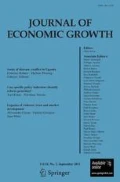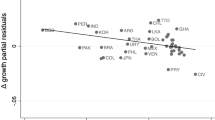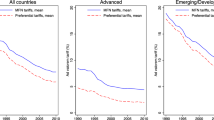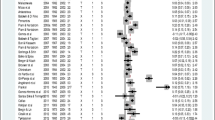Abstract
This article uses a new database to establish a key finding: high tariffs were associated with fast growth before World War II, while they have been associated with slow growth thereafter. The paper offers explanations for the sign switch by controlling for novel measures of the changing world economic environment. Rejecting alternative explanations based on changing export market growth or transportation cost declines, it shows how the modern negative correlation could be reversed in a world environment characterized by a moderately higher generalized tariff protection such as that which prevailed before 1914. We show that an increase in average tariff rates among trading partners by just one third might suffice to reverse any negative relationship between an average country's tariffs and its growth. An increase in own tariffs after 1950 hurt or at least didn't help growth, but it might have helped growth in a world where average trading partners' tariffs were moderately higher and retaliation was the best strategy. The world environment matters. Leader-country reaction to big world events matters.
Similar content being viewed by others
References
Anderson, J. E. (1998). ‘Trade Restrictiveness Benchmarks,’ Economic Journal 108(July), 1111–1125.
Anderson, J. E., and J. P. Neary. (1994). ‘Measuring the Restrictiveness of Trade Policy,’ World Bank Economic Review 8(May), 151–169.
Anderson, T. W., and C. Hsiao. (1981). ‘Estimation of Dynamic Models with Error Components,’ Journal of the American Statistical Association 76, 598–606.
Bagwell, K., and R. W. Staiger. (2002). The Economics of the World Trading System. Cambridge, MA: MIT Press.
Bairoch, P. (1972). ‘Free Trade and European Economic Development in the 19th Century,’ European Economic Review 3(November), 211–245.
Baldwin, R. E., and R. Forslid. (2000). ‘Trade Liberalisation and Endogenous Growth: A q-Theory Approach,’ Journal of International Economics 50, 497–517.
Ben-David, D., and M. B. Loewy. (1998). ‘Free Trade, Growth, and Convergence,’ Journal of Economic Growth 3, 143–170.
Bhagwati, J., and A. O. Krueger (eds.). (1973–1976). Foreign Trade Regimes and Economic Development, multiple volumes with varying authorship. New York: Columbia University Press.
Blattman, C., M. A. Clemens, and J. G. Williamson. (2002). ‘Who Protected and Why? Tariffs the World Around 1870–1937.’ Paper presented to the Conference on the Political Economy of Globalization, Trinity College, Dublin (August 29–31).
Bloom, D. E., and J. G. Williamson. (1998). ‘Demographic Transitions and Economic Miracles in Emerging Asia,’ World Bank Economic Review 12(September), 419–455.
Capie, F. (1983). ‘Tariff Protection and Economic Performance in the Nineteenth Century.’ In J. Black and L. A. Winters (eds.), Policy and Performance in International Trade. London: Macmillan.
Coatsworth, J. H., and J. G. Williamson. (2002). ‘The Roots of Latin American Protectionism: Looking Before the Great Depression.’ NBER Working Paper 8999, National Bureau of Economic Research, Cambridge, MA (June).
Dixit, A. (1987). ‘Strategic Aspects of Trade Policy.’ In Truman F. Bewley (ed.), Advances in Economic Theory: Fifth World Congress. New York: Cambridge University Press.
Dollar, D. (1992). ‘Outward-Oriented Developing Economies Really Do Grow More Rapidly: Evidence from 95 LDCs, 1976–1985,’ Economic Development and Cultural Change 40(April), 523–544.
Dollar, D., and A. Kraay. (2001). ‘Trade, Growth, and Poverty.’ World Bank Policy Research Department Working Paper No. 2615, Washington, D.C. (March).
Easterly, W. (1993). ‘How much do Distortions Affect Growth?’ Journal of Monetary Economics 32(2), 187–212.
Eckes, A. (1995). Opening America's Market: U.S. Foreign Trade Since 1776. Chapel Hill: University of North Carolina Press.
Edwards, S. (1993). ‘Openness, Trade Liberalization, and Growth in Developing Countries,’ Journal of Economic Literature 31(September), 1358–1394.
Frankel, J., and D. Romer. (1999). ‘Does Trade Cause Growth?’ American Economic Review 89(June), 379–399.
Greenaway, D., W. Morgan, and P. Wright. (2002). ‘Trade Liberalisation and Growth in Developing Countries,’ Journal of Development Economics 67, 229–244.
Grossman, G. M., and E. Helpman. (1991). Innovation and Growth in the Global Economy. Cambridge, MA: MIT Press.
Hadi, A. S. (1992). ‘Identifying Multiple Outliers in Multivariate Data,’ Journal of the Royal Statistical Society Series B 54, 761–771.
Hadi, A. S. (1994). ‘A Modification of a Method for the Detection of Outliers in Multivariate Samples,’ Journal of the Royal Statistical Society Series B 56, 393–396.
Harrison, A. (1996). ‘Openness and Growth: A Time-Series, Cross-Country Analysis for Developing Countries,’ Journal of Development Economics 48, 419–447.
Irwin, D. A. (1998). ‘Changes in U.S. Tariffs: The Role of Import Prices and Commercial Policies?’ American Economic Review 88(September), 1015–1026.
Irwin, D. A. (2001). ‘Tariffs and Growth in Late Nineteenth Century America,’ World Economy 24(January), 15–30.
Irwin, D. A. (2002). ‘Did Import Substitution Promote Growth in the Late Nineteenth Century?’ NBER Working Paper 8751, National Bureau of Economic Research, Cambridge, MA (February).
Irwin, D. A., and M. Terviö. (2002). ‘Does Trade Raise Income? Evidence from the Twentieth Century,’ Journal of International Economics 58(1), 1–18.
Judson, R. A., and A. L. Owen. (1999). ‘Estimating Dynamic Panel Data Models: A Guide for Macroeconomists,’ Economic Letters 65, 9–15.
Krueger, A. O. (1983). ‘The Effects of Trade Strategies on Growth,’ Finance and Development 20(June), 6–8.
Krueger, A. O. (1984). ‘Trade Policies in Developing Countries,’ in Ronald Jones and Peter Kenan (eds.), Handbook of International Economics, Vol. 1. Amsterdam: North-Holland.
Lane, P. R. (2001). ‘International Trade and Economic Convergence: The Credit Channel,’ Oxford Economic Papers 53, 221–240.
Lewis, W. A. (1978). The Evolution of the International Economic Order. Princeton: Princeton University Press.
Lindert, P. H., and J. G. Williamson. (2003). ‘Does Globalization Make the World More Unequal?’ In M. Bordo, Alan M. Taylor, and Jeffrey G. Williamson (eds.), Globalization in Historical Perspective. Chicago: University of Chicago Press for NBER.
Nickell, S. (1981). ‘Biases in Dynamic Models with Fixed Effects,’ Econometrica 49, 1417–1426.
O'Rourke, K. H. (1997). ‘Measuring Protection: A Cautionary Tale,’ Journal of Development Economics 53, 169–183.
O'Rourke, K. H. (2000). ‘Tariffs and Growth in the Late 19th Century,’ Economic Journal 110(April), 456–483.
Osang, T., and A. Pereira. (1996). ‘Import Tariffs and Growth in a Small Open Economy,’ Journal of Public Economics 60, 45–71.
Pritchett, L. (1996). ‘Measuring Outward Orientation in LDCs: Can It Be Done?’ Journal of Development Economics 49, 307–335.
Pritchett, L., and G. Sethi. (1994). ‘Tariff Rates, Tariff Revenue, and Tariff Reform: Some New Facts,’ The World Bank Economic Review 8(1, January), 1–16.
Rodríguez, F., and D. Rodrik. (2001). ‘Trade Policy and Economic Growth: A Skeptic's Guide to the Cross-National Evidence.’ In Ben Bernanke and Kenneth S. Rogoff (eds.), Macroeconomics Annual 2000, Cambridge, MA: MIT Press for NBER.
Sachs, J. D., and A. Warner. (1995). ‘Economic Reform and the Process of Global Integration,’ Brookings Papers on Economic Activity 1, 1–118.
Vamvakidis, A. (2002). ‘How Robust Is the Growth-Openness Connection? Historical Evidence,’ Journal of Economic Growth 7, 57–80.
Williamson, J. G. (1998). ‘Globalization, Labor Markets and Policy Backlash in the Past,’ Journal of Economic Perspectives 12(Fall), 51–72.
Williamson, J. G. (2003). ‘Was It Stolper-Samuelson, Infant Industry or Something Else? World Tariffs 1789–1938.’ NBER Working Paper 9656, National Bureau of Economic Research, Cambridge, MA (April).
Wright, G. (1990). ‘The Origins of American Industrial Success, 1879–1940,’ American Economic Review 80(September), 651–668.
Author information
Authors and Affiliations
Rights and permissions
About this article
Cite this article
Clemens, M.A., Williamson, J.G. Why did the Tariff–Growth Correlation Change after 1950?. Journal of Economic Growth 9, 5–46 (2004). https://doi.org/10.1023/B:JOEG.0000023015.44856.a9
Issue Date:
DOI: https://doi.org/10.1023/B:JOEG.0000023015.44856.a9




